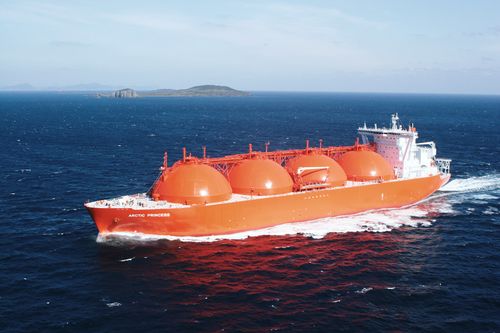LNG as fuel has long been considered the industry’s last, best hope to meet the IMO’s ambitious targets to reduce greenhouse gas (GHG) emissions by 2030. So why aren’t we seeing more LNG retrofits on existing tonnage? In April 2018, MEPC 72 adopted resolution MEPC.304(72) on the Initial IMO Strategy on reduction of GHG emissions from ships. The IMO has called for the industry to reduce its average carbon intensity by up to 40% by 2030 and by 70% in 2050, compared to 2008.
Owner skepticism. The IMO’s bold vision was applauded by politicians, the press, climate change activists and many industry stakeholders but unless the industry transitions to low carbon fuels, meeting these targets will be impossible. But because the IMO did not specify how these targets might be met, the resolution left owners with more questions than answers. What alternative fuels make sense? Is there adequate bunkering infrastructure? And more to the point, who pays? For years, natural gas has been regarded as the “marine fuel of the future.” After all, LNG is readily available, affordable and since it has negligible NOx, Particulate Matter (PM) and zero SOx emissions, it will help owners comply with the IMO’s vision. But the introduction of other alternative fuels solutions, such as hydrogen, ammonia, biofuels, and battery hybrid systems caused many owners to hesitate and ask: “Why invest in LNG retrofits if natural gas will be replaced by fuels with lower GHG impacts?”
Slipping up. Others point to recent studies highlighting the impacts of methane slip, an issue specific to gas-fueled engine systems. Methane slip can occur during the gas exchange phase of the cycle when unused fuel can get trapped in the combustion chamber and top piston area, allowing some unburned methane gas to escape at the exhaust into the atmosphere. Methane slip not only results in less efficiency (thus higher fuel costs), it may add to the GHG impacts, as Methane is a major contributor to global warming. In a February press conference in London, DNV GL’s maritime chief executive officer, Knut Ørbeck-Nilssen, acknowledged that low carbon biodiesel, hydrogen, ammonia and synthetic fuels are promising, but they would take time to develop. “The pathway to carbon neutral fuels starts with gas,” he stated. “It is important to act now and not to wait for the ‘perfect’ fuel.”
As for emissions, Mr Ørbeck-Nilssen pointed out that Methane leakage had been drastically reduced in modern engines, and further improvements could be expected. Citing data provided from engine manufacturer Wärtsilä, over the last decade, gas engines have outperformed engines running Marine Gas Oil (MGO) in terms of GHG emissions.
Engine technologies. Cato Esperø, Wärtsilä’s head of marine sales (Norway) confirmed that the company’s engineers have continuously improved the emissions performance of its dual fuel engines (notably the 46DF, 50DF, 31DF), which allow ships to operate using a broad range of fuels, including heavy fuel oil, MGO, light fuel oil, bio fuel and LNG. The company has also introduced the 31SG, an engine optimized to run on gas alone, and provides customers with the Wärtsilä Methane Number Calculator, a tool to help shipowners and operators calculate methane values in the fuel gas. “Wärtsilä is a pioneer in the development of sustainable engine systems, including battery hybrid solutions and is working with other key industry stakeholders to achieve zero-emissions shipping,” he said. “Until we succeed, we believe LNG retrofits represent the best, most viable option.” Mr Esperø acknowledged that LNG retrofits are expensive, but is quick to point out that owners willing to make the investment now will be in a better position to migrate to other alternative fuels as they become available. “It is important that owners secure fuel flexibility to fit their operational profile, in the short, medium and long term,” he said. “For most owners, a dual fuel/LNG setup reduces business risk and provides flexibility with regards to availability of new fuels during the transition.”
The cost of sustainability. In a world still in the grip of the pandemic, one can forgive owners for being slow to book retrofits at their favorite yards. After all, LNG conversions are expensive, time consuming and in some shipping segments, LNG tanks can reduce valuable cargo space. Nevertheless, Lianghui Xia managing director of Newport Shipping UK, a global service provider for ship repair and retrofit, argues that further delays will all but ensure the industry will fail to meet IMO targets. “The time to act is now,” he said. “Natural gas may not be perfect, but let us not make perfect the enemy of good.” Xia acknowledges that more promising fuels are on the horizon, but for the next 5-10 years, LNG as fuel represents the only credible and achievable mid-term solution in cutting emissions. Yet so far, only a small fraction of the world fleet runs on natural gas. “Newport Shipping recognizes that the number one challenge for owners is cost, so in addition to providing turnkey solutions that includes equipment procurement, full-scope design work, on-site project execution, we offer a 5-7-year payment plan without fixed vessel mortgage collateral.”
Collective action required. But that may not be enough. Indeed, Xia notes that if the world is serious about cutting maritime emissions, it will require more than efficient engines, skilled yards and short-term financing options. “Right now, many owners willing to make the change simply don’t have the capital to invest in conversions,” he said. “To reach IMO targets will take a collective effort.” Xia believes that governments could offer tax incentive schemes to reward owners and charterers could help subsidize conversions to achieve lower emissions throughout the value chain. Ports could work with logistics providers to improve bunkering access, and energy companies, which would benefit from greater demand, could help by lowering the production and delivery costs of natural gas. “If climate change is a shared challenge, then so is the solution,” he explained. “Owners should not be forced to bear the costs alone.”
SOURCE: https://vpoglobal.com/2020/09/09/lng-retrofits-the-time-is-now/
